Resisted and Assisted Training for Sprint Speed: A Brief Review
Whitney D Leyva, Megan A Wong and Lee E Brown*
Department of Kinesiology, California State University, Fullerton, USA
Submission: March 19, 2017; Published: March 28, 2017
*Corresponding author: Lee E. Brown, Department of Kinesiology, Center for Sport Performance and Human Performance Laboratory, California State University, Fullerton, KHS 192, 800 N. State College Blvd, Fullerton, CA 92831, USA, Tel: [657] 278-3428;Email: leebrown@fullerton.edu
How to cite this article: Leyva WD, Wong MA, Brown LE. Resisted and Assisted Training for Sprint Speed: A Brief Review. J Phy Fit Treatment & Sports. 2017; 1(1): 555554 DOI: 10.19080/JPFMTS.2017.01.555554
Abstract
Speed and acceleration are important components of most sports. There are various ways to train for these, both in and out of the weight room. Outside the weight room, resisted and assisted methods are used in training programs to increase performance. Therefore, the aim of this brief review is to examine methodological differences between these two approaches while concluding with specific training programs unique to resisted and assisted techniques designed to increase sprint speed and acceleration.
Keywords: Sled; Towing; Downhill Running; Weighted Vest
Introduction
Sprinting speed and acceleration can be found in major sports such as soccer, football, baseball, and basketball. Speed is defined as maximal running velocity and is calculated by dividing distance traveled by time, usually expressed as meters per second (m/s). Similarly, acceleration is defined as the rate of change of velocity and is calculated by dividing change in speed by time, usually expressed as m/s/s or simply m/s2. Coaches implement a variety of training programs to increase both components, and athletes are always searching for the best ways to improve their performance. An assortment of different approaches have been implemented to increase speed such as resistance training to increase strength [1,2]. Implementation of specific sprint training along with nonspecific methods can increase speed and athletic performance [3]. In this way, training specificity seeks to promote adaptations with a direct carryover to sport. Two specific sprint speed programs that are popular with strength coaches are overload or resisted training and over speed or assisted training [4-6].
Resisted training consists of applying an overload via a sled, parachute or weighted vest [7,2] while assisted training consists of over speed via downhill running, elastic cord assistance or assisted towing [4,8,9]. Resisted and assisted training methods result in specific adaptations and performance enhancements. The purpose of this article is to briefly review the current literature related to resisted and assisted sprint training and attempt to elucidate best practices for these two divergent methods for strength and conditioning coaches.
Resisted/Overload
Since speed and acceleration are essential components of many field sports, resisted sprinting is a common form of strength-specific training. In sprinting, acceleration occurs over the first 5 to 15 meters, so this short distance is a fundamental component in field sports as it requires quickness. Adding additional resistance as an overload stimulus may help improve the speed of athletes via increased leg strength. Sprinting is similar in comparison to the movement pattern while pulling the additional resistance used as an overload stimulus. Common methods used to create this overload stimulus include sled towing, parachute towing, and weighted vest sprinting. As these devices are being implemented in training programs, optimal loads must be considered to improve the acceleration or maximum velocity phase of sprinting.
Sled towing (Figure 1)
Lockie et al. [10] investigated the optimal towing load by comparing heavy (32.2% bodyweight-BW) and light loads (12.6% BW) using 20 male participants active in field sports. Heavy loads resulted in greater kinematic changes during the acceleration phase when compared to light loads. Therefore, they concluded that towing with lighter loads was preferred for training. Alcaraz et al. [11] loaded a sled to 16% BW using 11 male and 7 female competitive athletes who specialized in either sprints or long jump and were experienced with resisted sprint devices. Their results demonstrated a greater increase in trunk lean compared to using a parachute and they concluded that 16% was near the optimal load for effective training during the maximum velocity phase. Murray et al. [12] compared 10 and 20 meter sprint performance over a range of relative towing resistance loads of 0%, 5%, 10%, 15%, 20%, 25%, and 30% BW using 13 male rugby players and 20 male football players. As load increased, time increased, stride length decreased and there with no change in stride frequency. Therefore, an optimal training load could not be recommended based on their results.
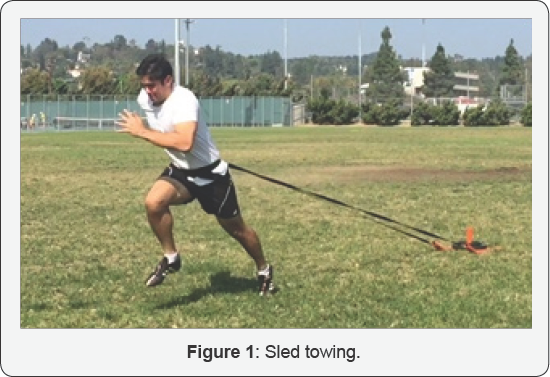
The long-term effects of sled towing on sprint performance with 20 male collegiate lacrosse players was examined by Clark et al. [5] using a load of 10% BW. They demonstrated significantly increased sprint velocity in the acceleration phase, with no effect in the maximum velocity phase. Smith [13] examined the acute effects of a post activation potentiating warm-up on subsequent sprint performance by having 24 an aerobically trained male and female participants complete 40-yd sprints while towing a sled of 0%, 10%, 20%, or 30% BW and saw that heavier loads demonstrated greater improvements in sprint speed. Kawamori et al. [14] compared the effects of heavy and light loads with a sled on sprint acceleration with 21 physically active males experienced in team sports such as soccer, field hockey, basketball, and Australian Rules football. The heavy load was 30% BW and the light was 10% BW. Following two training sessions per week for 8 weeks, the heavy sled group significantly improved time for the 5-m and 10-m sprint, whereas the light load group significantly improved only at 10-m. Harrison et al. [7] conducted a study consisting of two training sessions per week for 6 weeks using 15 professional or semiprofessional male rugby players to examine improvements in running speed and dynamic strength measures. A sled was loaded using 12.613% BW, which resulted in significant decreases in time for the 5-m split of a 30-m sprint. Thus, resisted sprint training may increase initial acceleration speed from a static start.
Cottle et al. [15] used loads of 10% or 20% BW with a sled tow to examine ground reaction force (GRF) impulse for a 10-m distance in 17 off-season NCAA Division III and University Sports' field and court athletes (10 males and 7 females). The 20% BW load was significantly greater in propulsive GRF than the 10% BW load for the front leg. Light loads were not a sufficient stimulus to increase propulsive GRF impulse, however the heavier load may provide an adequate stimulus to improve sprint starts. West et al. [16] compared the effects of combined weighted sled towing and sprinting vs. bodyweight sprinting with two training sessions per week for 6 weeks with 20 professional rugby union players. Sled towing consisted of using 12.6% BW for 10-m and 30-m distances. Combined training demonstrated significantly reduced sprint times in the 10-m and 30-m sprint.
Parachute running (Figure 2)
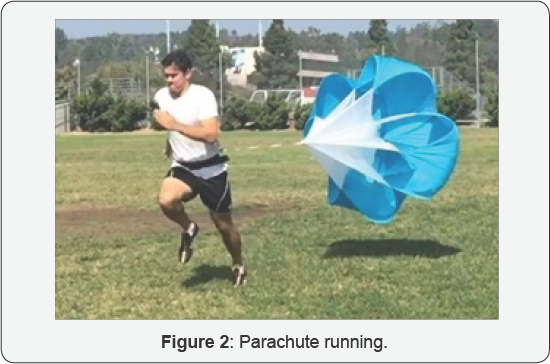
Another resisted sprint device is using a parachute as overload. Alcaraz et al. [11] examined the kinematic effects of sled towing, parachute running, and weighted vest sprints on stride length and speed for flying sprints over 30-m. A medium sized parachute was attached at the waist by a harness where only minor changes occurred in running technique while using the different devices. A medium sized parachute (1.2 x 1.2m) was recommended to provide an overload stimulus due to minor changes in running technique. Martinopoulou et al. [17] examined the effects of alarge parachute vs. un resisted sprint training on acceleration and maximum speed over 20m in 16 sprinters. The parachute group made improvements in running velocity in the acceleration phase while the unresisted group demonstrated no significant improvements.
Weighted vest sprinting (Figure 3)
Alcaraz et al. [11] loaded a weight vest at 9% BW while examining the sprint kinematics of maximum velocity running. The loaded vest did not produce significant differences, however athletes had shorter take-off distances. This could indicate there was no full extension of the leg at take-off. Clark et al. [5] investigated the long-term effects of weighted sled and weighted vest sprinting in a 7-week training program with collegiate male lacrosse players using a weighted vest of 18.5% BW. Their results indicated that weighted vest sprints had no beneficial effect on speed. Konstantinos et al. [18] examined the acute effects of various loading conditions on a 50m sprint in the acceleration, maximum velocity, and final phase in 24 sport science students experienced in sprinting or soccer. Weighted vests of 8%, 15%, and 20% BW were used and they found that an 8% BW load significantly increased sprint performance at 40-m, 15% BW significantly increased sprint at 20m and 40m while 20% BW increased sprint at 10-m and 40m. Additionally, leg power and sprint performance were significantly correlated with the 0%, 8%, and 15% conditions at 10, 20, 30, 40, and 50m, while the 20% load was correlated only at 30, 40, and 50m. Participants with greater leg power were more affected by heavier loads during the acceleration phase while participants with less leg power showed decreasing results for all loading conditions. Based on their findings, implementing weighted vest sprint training can best be used for either the acceleration or max velocity phase from 0-50 meters.
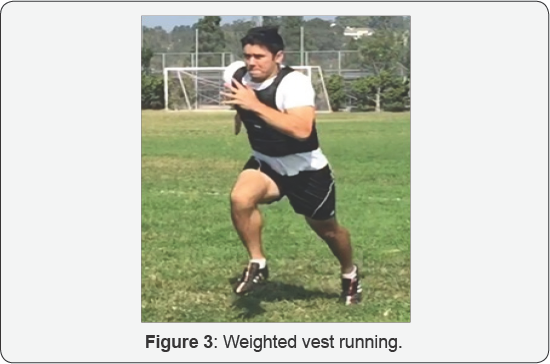
Summary
A variety of methods such as sled towing, parachute running, and weighted vest sprinting may provide an overloaded stimulus to an athlete. Incorporating these methods for resisted sprint training programs varies based on the desired outcome (Table 1). Various loads and distances may be altered to enhance acceleration or maximum speed.

Assisted/Overspeed
Assisted sprinting or overspeed training allows the athlete to run faster than they normally do at maximal speeds. Training methods consist of downhill running; elastic cord assisted running or assisted towing. Building a strong conditioning base before starting overspeed training is recommended.
Downhill running (Figure 4)
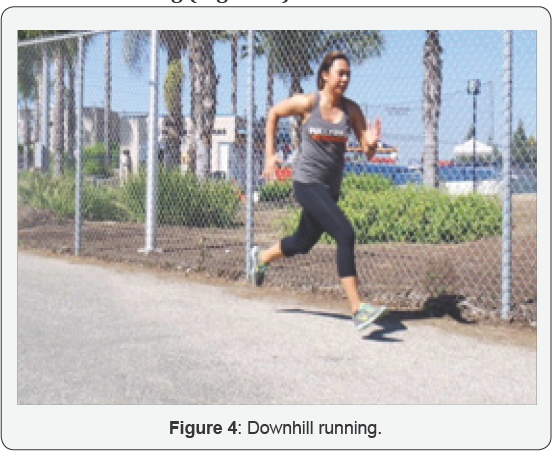
Methods such as downhill sprinting have been shown to increase maximal acute running speed. Two studies done by Ebben et al. [19,20] investigated the optimal slope for downhill sprinting by having 13 NCAA Division III athletes run downhill at 0, 2.1°, 3.3°, 4.7°, 5.8°, and 6.9°. Running at a slope between 3.45.8° was optimal for increasing maximal speed and acceleration in the athletes. A slope of 6.9° was the point of diminishing returns due to possible breakdown in running mechanics and braking. Paradisis et al. [8,21] examined the effects of sprint training on sloping surfaces by having subjects run uphill- downhill, downhill, uphill, horizontal, or flat. The training consisted of physical education students running on an uphill- downhill platform which consisted of a 20-m horizontal section, a 20-m 3° uphill section, a 10-m horizontal section, a 20-m 3° downhill section, and a final 10-m horizontal section, thus, an overall 35-m sprint test was used to assess the effects of different types of training. Following six weeks, maximum running speed and step rate were significantly increased for both the combined uphill-downhill training group and the downhill group. There were no significant changes for the control or horizontal groups. The uphill-downhill group shortened flight time by 6ms. Therefore, training with a downhill slope of 3° has also been shown to increase maximum running speed. This can be a cost effective way for a strength coach to increase sprint speed.
Elastic cord assistance running (Figure 5)
Elastic cords are used to assist the runner to sprint faster than normal by a percentage of their BW [2]. Bartolini et al. [4] examined the optimal elastic cord assistance level for sprinting in collegiate women soccer playersat0, 10, 20, 30, and 40% BW assistance and found that an elastic cord assistance level of 30% of BW was optimal to decrease sprint times over 20m and 5m splits. In contrast, Clark et al. [22] examined the influence of assistance force magnitude on the kinematics of supramaximal sprinting. Ten high school and college-age (6 men, 4 women) track and field athletes ran 60-m under 5 conditions of 0, 2.0%, 2.8%, 3.8% and 4.7% of BW. An elastic cord was attached to the subjects via a waist belt while the other end was attached to an anchor. Results showed a decrease in contact time for all conditions. They concluded that towing force magnitude influenced kinematics. They concluded that a towing force greater than 3.8% was detrimental because of the negative effects it had on the running mechanics of the athlete. However, they did not perform a training study.

In a similar manner, albeit not a sprint study, Girold et al. [23] examined assisted and resisted training in competition level swimmers between over strength, overspeed, and control groups. The overspeed group performed25m freestyle front crawl sprints while attached to an elastic cord pulled with an initial force of 60N. The overstrength group swam all out 30 second front crawl sprints with a 30-second recovery while tethered to the starting platform via a belt around their pelvis stretched over an average distance of 15m. The control group swam 50m front crawl sprints without any device. For both the over strength and overspeed groups, swim performance was significantly improved over the second 50m of a 100m swim and the over strength group showed a larger impact on muscle strength and stroke technique than the overspeed group. However, the overspeed group significantly increased stroke rate while stroke length significantly decreased compared to the over strength group.
Assisted towed running (Figure 6)
A third type of assisted training is towing where the focus is on increasing a sprinters stride frequency. Towing usually involves two people, one pulling the other, with the person being towed focusing on overspeed training. Nealer et al. [24] used 30% bodyweight assistance to determine the acute effects of rest intervals following a 20m bodyweight sprint. Sprint time was faster for the 0-5m split after a 1min and 2 min rest. Upton et al. [6] compared the effects of different training programs using resisted, assisted, or traditional sprinting on maximal velocity and acceleration in Division 1A female soccer athletes. All subjects completed 10 maximal 20-yd sprints followed by a 20-yd deceleration. The assisted training group was attached to a speed harness via a research assistant. The resisted training group ran ata load of 12.6% BW, producing a sprint speed equal to 90% of their maximal speed. The traditional training group performed maximal20-yd BW sprints. Results showed that maximum 40-yd velocity increased for both the assisted (0.08 m/s) and resisted (0.06 m/s) training groups while 5-yard, 15-yd, and 5-15yd acceleration increased only for the assisted training group. Speed was unchanged for the traditional sprint training group. Assisted sprint training was effective for athletes involved in short distance acceleration runs ≤15yd, and also those events that require maximum velocity at distances >15yd should use resisted training methods.
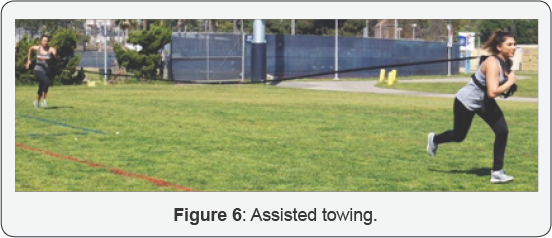
Corn et al. [25] examined the specificity of elastic-cord towing on the kinematics of acceleration with collegiate sprinters performing 20 meter maximal sprints and towed sprints. Towed sprints were performed using a speed harness with an elastic band assistance of 40-50N of horizontal towing force. There was no significant difference in stride rate between conditions. However, elastic-cord towing resulted in changes in sprint kinematics in the acceleration phase and appears to be more sprint specific compared to maximal sprinting alone. Grabowski et al. [26] had 15 healthy adults complete running trials on 4 different days on a motorized treadmill. Day 1 consisted of a running economy and VO2Max test, day 2 was a 10-km time trial, day 3 was a 10-km time trial with horizontal towing applied to their waist, and on day4 subjects completed a 7-min standing trial and three sub-max 7-min running trials. Their results showed that towing improved overall running performance.
Summary
The importance of assisted sprint training is that it involves an overspeed stimulus that maximum speed running (bodyweight) cannot provide alone. Programming for assisted sprint training uses a variety of methods such as downhill running, elastic cord assisted running, or assisted towed running (Table 2). These methods help athletes reach speeds they are unable to reach without assistance (supramaximal). The novelty of these methods can add variety to training programs and enhance speed.

Conclusion
The previous studies demonstrate that overspeed or assisted and overload or resisted training can increase acceleration and maximal running speed. With resisted sprint training, the critical variables of load, volume, and rest must be altered. Accordingly, load, volume, and restare different for assisted sprint training. Depending on the needs of the athlete, strength and conditioning coaches should plan a specific training program to enhance speed or acceleration. Refer to Tables 1 & 2 for critical program design variables for assisted or resisted acceleration and speed training. Resisted sprinting is a common way to train for speed. Coaches and athletes may consider using resistance methods such as a sled, parachute, or weighted vest in order to apply an overloaded stimulus to train for muscular strength. Assisted sprinting is a less popular form but has shown many benefits. Coaches and athletes wanting to acutely reduce ground contact time, increase stride length and frequency should use overspeed training methods such as downhill running, elastic cord assistance, or assisted towing. For the greatest enhancement of acceleration and speed, both assisted and resisted training techniques should be utilized where appropriate.
References
- Moir G, Sanders R, Button C, Glaister M (2007) The effect of periodized resistance training on accelerative sprint performance. Sport Biomech 6(3): 285-300.
- Young W, Benton D, John Pryor M (2001) Resistance training for short sprints and maximum-speed sprints. Strength & Cond J 23: 7.
- Rumpf MC, Lockie RG, Cronin JB, Jalilvand F (2016) The effect of different sprint training methods on sprint performance over various distances: a brief review. J Strength Cond Res 30(6): 1767-1785.
- Bartolini JA, Brown LE, Coburn JW, Judelson DA, Spiering BA, et al. (2011) Optimal elastic cord assistance for sprinting in collegiate women soccer players. J Strength Cond Res 25(5): 1263-1270.
- Clark K, Stearne D, Walts C, Miller A (2010) The longitudinal effects of resisted sprint training using weighted sleds vs. weighted vests. J Strength Cond Res 24(12): 3287-3295.
- Upton DE (2011) The effect of assisted and resisted sprint training on acceleration and velocity in Division IA female soccer athletes. J Strength Cond Res 25(10): 2645-2652.
- Harrison AJ, Bourke G (2009) The Effect of Resisted Sprint Training on Speed and Strength Performance in Male Rugby Players. J Strength Cond Res 23: 275-283.
- Paradisis GP, Bissas A, Cooke CB (2009) Combined uphill and downhill sprint running training is more efficacious than horizontal. Int J Sports Physiol Perform 4(2): 229-243.
- Paradisis GP, Cooke CB (2006) The effects of sprint running training on sloping surfaces. J Strength Cond Res 20(4): 767-777.
- Lockie R, Murphy A, Spinks C (2014) Effects of resisted sled towing on sprint kinematics in field-sport athletes. J Strength Cond Res 17(4): 760-767.
- Alcaraz PE, Palao JM, Elvira JLL, Linthorne NP (2008) Effects of three types of resisted sprint training devices on the kinematics of sprinting at maximum velocity. J Strength Cond Res 22(3): 890-897.
- Murray A, Aitchison T, Ross G, Sutherland K, Watt I, et al. (2005) The effect of towing a range of relative resistances on sprint performance. J Sport Sci 23(9): 927-935.
- Smith CE, Hannon JC, McGladrey B, Shultz B, Eisenman P, et al. (2014) The effects of a postactivation potentiation warm-up on subsequent sprint performance. Human Movement 15: 36-44.
- Kawamori N, Newton R, Hori N, Nosaka K (2014) Effects of weighted sled towing with heavy versus light load on sprint acceleration ability. J Strength Cond Res 28(10): 2738-2745.
- Cottle CA, Carlson LA, Lawrence MA (2014) Effects of sled towing on sprint starts. The J Strength Cond Res 28: 1241-1245.
- West D, Cunningham D, Bracken R, Bevan H, Crewther B, et al. (2013) Effects of resisted sprint training on acceleration in professional rugby union players. J Strength Cond Res 27(4): 1014-1018.
- Martinopoulou K, Argeitaki P, Paradisis G, Katsikas C, Smirniotou A (2011) The effects of resisted training using parachute on sprint performance. Bio Sci 7(1): 8-23.
- Konstantinos Z AS, Polyxeni A, Georgios P, Elias Z, Charilaos T (2014) Effects of loading using a weighted vest on running performance. Bio Ex 10(1): 54-65.
- Ebben WP (2008) The optimal downhill slope for acute overspeed running. Int J Sports Physiol Perf 3: 88-93.
- Ebben WP, Davies JA, Clewien RW (2008) Effect of the degree of hill slope on acute downhill running velocity and acceleration. J Strength Cond Res 22(3): 898-902.
- Paradisis GP, Cooke CB (2001) Kinematic and postural characteristics of sprint running on sloping surfaces. J Spt Sci 19(2): 149-159.
- Clark DA, Sabick MB, Pfeiffer RP, Kuhlman SM, Knigge NA, et al. (2009) Influence of towing force magnitude on the kinematics of supramaximal sprinting. J Strength Cond Res 23: 1162-1168.
- Girold S, Calmels P, Maurin D, Milhau N, Chatard JC (2006) Assisted and resisted sprint training in swimming. J Strength Cond Res 20(3): 547-554.
- Nealer AL, Dunnick DD, Malyszek KK, Wong MA, Costa PB, et al. (2017) Influence of rest intervals after assisted sprinting on bodyweight sprint times in female collegiate soccer players. The Journal of Strength &Conditioning Research 31: 88-94.
- Corn R, Knudson D (2003) Effect of elastic-cord towing on the kinematics of the acceleration phase of sprinting. J Strength Cond Res17: 72-75.
- Grabowski AM, Kram R (2008) Running with horizontal pulling forces:the benefits of towing. Euro J Appl Physiol104(3): 473-479.






























